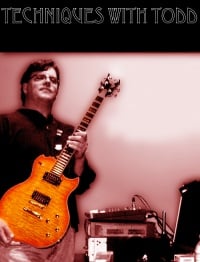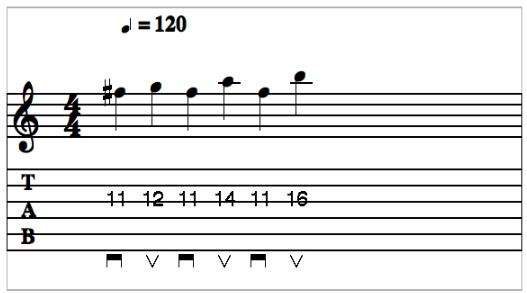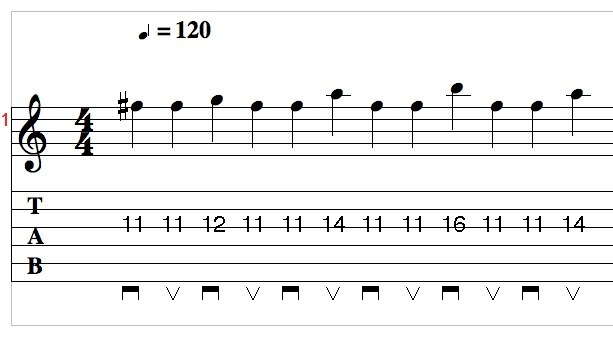Lesson Series: “0 To 60, An Introduction to Alternate Picking” - Lesson 6
| (7 intermediate revisions not shown.) | |||
| Line 2: | Line 2: | ||
[[Image:toddsimp2.jpg|thumb|200px|Todd Simpson]] | [[Image:toddsimp2.jpg|thumb|200px|Todd Simpson]] | ||
| - | ==LESSON # | + | ==LESSON #6 - Pedal Point/Tone== |
<br> | <br> | ||
| Line 29: | Line 29: | ||
<br> | <br> | ||
| - | We are going to keep our Pedal Tone fretted and move our other fingers to different frets. All the while, we will be alternate picking. The shape we are going to work with is part of the Natural Minor Scale and can be played in any key. Again, make sure to start off very slowly until you get the pattern down and can alternate your pick strokes consistently. This will take some focus and effort at first. As you progress it will get more and more easy and you will be able to play the pattern with ever increasing speed. | + | LESSON #6 - Pedal Point/Tone |
| + | |||
| + | In this lesson, we are going to use something called a "Pedal Point" or "Pedal Tone". This is basically using one note as the base in a shape or scale and coming back to it again and again. Before we get to far ahead of ourselves, read the following. It's an explanation of "Pedal Point" from Wikipedia Source: Pedal Point on Wikipedia. | ||
| + | |||
| + | |||
| + | In tonal music, a pedal point (also pedal tone, pedal note, organ point, or pedal) is a sustained tone, typically in the bass, during which at least one foreign, i.e., dissonant harmony is sounded in the other parts. A pedal point is a "non-chord tone", which puts it in the same musical categories as suspensions, retardations, and passing tones. However, the pedal point is unique among non-chord tones "in that begins on a consonance, sustains (or repeats) through another chord as a dissonance until the harmony" not the non-chord tone, "resolves back to a consonance." | ||
| + | |||
| + | Pedal points "have a strong tonal effect, 'pulling' the harmony back to its root." When a pedal point occurs in a voice other than the bass, it is usually referred to as an inverted pedal point[2] (see inversion (music)). Pedal points are usually on either the tonic or the dominant (fifth note of the scale) tones. The pedal tone is considered a chord tone in the original harmony, then a nonchord tone during the intervening dissonant harmonies, and then a chord tone again when the harmony resolves. A dissonant pedal point may go against all harmonies present during its duration, being almost more like an added tone than a nonchord tone, or pedal points may serve as atonal pitch centers. | ||
| + | |||
| + | The term comes from the organ for its ability to sustain a note indefinitely and the tendency for such notes to be played on an organ's pedal keyboard. The pedal keyboard on an organ is played by the feet; as such, the organist can hold down a pedal point for lengthy periods while both hands perform higher-register music on the manual keyboards. | ||
| + | |||
| + | Rock guitarists have used pedal points in their solos, especially neoclassical guitarists such as Yngwie Malmsteen. Other rock guitarists that use pedal points in solos are Steve Vai, Joe Satriani, Eric Johnson, John Petrucci, Jason Becker, Paul Gilbert, John Sykes and Vinnie Moore. Pedal points can be heard on records such as Vinnie Moore's "Time Odyssey" and "Mind's Eye"'; Yngwie Malmsteen's "Rising Force"; Jason Becker's "Perpetual Burn"; and Richie Kotzen's "Fever Dream". Thrash metal in particular makes abundant use a muted low E string (or lower, if other tunings are used) as a pedal point. Examples of thrash metal bands that make use of a muted low E string pedal point include: Slayer, Metallica, Megadeth and Anthrax. In small combo jazz or jazz fusion groups, the double bass player or Hammond organist may also introduce a pedal point (usually on the tonic or the dominant) in a tune that does not explicitly request a pedal point, to add tension and interest. | ||
| + | |||
| + | |||
| + | We are going to keep our Pedal Tone fretted and move our other fingers to different frets. All the while, we will be alternate picking. The shape we are going to work with is part of the Natural Minor Scale and can be played in any key. Again, make sure to start off very slowly until you get the pattern down and can alternate your pick strokes consistently. This will take some focus and effort at first. As you progress it will get more and more easy and you will be able to play the pattern with ever increasing speed. This technique is a great way to work on alternate picking while working on your finger stretch at the same time. Be sure to warm up your fingers and hands before this and every practice session. Do some range of motion movements, wrist rolls, gentle finger stretches, etc. before you start your metronome. | ||
[[Image:toddsi51.jpg]] | [[Image:toddsi51.jpg]] | ||
| + | Once you have this down, try it a slightly different way. This is how it's played in the video. Incorporating both single and double strikes. | ||
| + | |||
| + | [[Image:tab6bbb.jpg]] | ||
| + | |||
| + | {{#ev:youtube|Q3pFR6Sb41I}} | ||
==Practice time== | ==Practice time== | ||
| Line 39: | Line 58: | ||
PRACTICE TIME (30 Minutes) Now that you have the pattern down, spend the rest of your practice time on the following. | PRACTICE TIME (30 Minutes) Now that you have the pattern down, spend the rest of your practice time on the following. | ||
| + | |||
| + | |||
| + | For this lesson, set your Metronome to 8/4 time if possible. | ||
Revision as of 12:29, 24 July 2012
Contents |
LESSON #6 - Pedal Point/Tone
Lesson Series by Todd Simpson
In this lesson, we are going to use something called a "Pedal Point" or "Pedal Tone". This is basically using one note as the base in a shape or scale and coming back to it again and again. Before we get to far ahead of ourselves, read the following. It's an explanation of "Pedal Point" from Wikipedia:
Pedal Point
"In tonal music, a pedal point (also pedal tone, pedal note, organ point, or pedal) is a sustained tone, typically in the bass, during which at least one foreign, i.e., dissonant harmony is sounded in the other parts. A pedal point is a "non-chord tone", which puts it in the same musical categories as suspensions, retardations, and passing tones. However, the pedal point is unique among non-chord tones "in that begins on a consonance, sustains (or repeats) through another chord as a dissonance until the harmony" not the non-chord tone, "resolves back to a consonance."
Pedal points "have a strong tonal effect, 'pulling' the harmony back to its root." [1] When a pedal point occurs in a voice other than the bass, it is usually referred to as an inverted pedal point[2] (see inversion (music)). Pedal points are usually on either the tonic or the dominant (fifth note of the scale) tones. The pedal tone is considered a chord tone in the original harmony, then a nonchord tone during the intervening dissonant harmonies, and then a chord tone again when the harmony resolves. A dissonant pedal point may go against all harmonies present during its duration, being almost more like an added tone than a nonchord tone, or pedal points may serve as atonal pitch centers.
The term comes from the organ for its ability to sustain a note indefinitely and the tendency for such notes to be played on an organ's pedal keyboard. The pedal keyboard on an organ is played by the feet; as such, the organist can hold down a pedal point for lengthy periods while both hands perform higher-register music on the manual keyboards.
Rock guitarists have used pedal points in their solos, especially neoclassical guitarists such as Yngwie Malmsteen. Other rock guitarists that use pedal points in solos are Steve Vai, Joe Satriani, Eric Johnson, John Petrucci, Jason Becker, Paul Gilbert, John Sykes and Vinnie Moore. Pedal points can be heard on records such as Vinnie Moore's "Time Odyssey" and "Mind's Eye"'; Yngwie Malmsteen's "Rising Force"; Jason Becker's "Perpetual Burn"; and Richie Kotzen's "Fever Dream". Thrash metal in particular makes abundant use a muted low E string (or lower, if other tunings are used) as a pedal point. Examples of thrash metal bands that make use of a muted low E string pedal point include: Slayer, Metallica, Megadeth and Anthrax. In small combo jazz or jazz fusion groups, the double bass player or Hammond organist may also introduce a pedal point (usually on the tonic or the dominant) in a tune that does not explicitly request a pedal point, to add tension and interest."
The lesson
LESSON #6 - Pedal Point/Tone
In this lesson, we are going to use something called a "Pedal Point" or "Pedal Tone". This is basically using one note as the base in a shape or scale and coming back to it again and again. Before we get to far ahead of ourselves, read the following. It's an explanation of "Pedal Point" from Wikipedia Source: Pedal Point on Wikipedia.
In tonal music, a pedal point (also pedal tone, pedal note, organ point, or pedal) is a sustained tone, typically in the bass, during which at least one foreign, i.e., dissonant harmony is sounded in the other parts. A pedal point is a "non-chord tone", which puts it in the same musical categories as suspensions, retardations, and passing tones. However, the pedal point is unique among non-chord tones "in that begins on a consonance, sustains (or repeats) through another chord as a dissonance until the harmony" not the non-chord tone, "resolves back to a consonance."
Pedal points "have a strong tonal effect, 'pulling' the harmony back to its root." When a pedal point occurs in a voice other than the bass, it is usually referred to as an inverted pedal point[2] (see inversion (music)). Pedal points are usually on either the tonic or the dominant (fifth note of the scale) tones. The pedal tone is considered a chord tone in the original harmony, then a nonchord tone during the intervening dissonant harmonies, and then a chord tone again when the harmony resolves. A dissonant pedal point may go against all harmonies present during its duration, being almost more like an added tone than a nonchord tone, or pedal points may serve as atonal pitch centers.
The term comes from the organ for its ability to sustain a note indefinitely and the tendency for such notes to be played on an organ's pedal keyboard. The pedal keyboard on an organ is played by the feet; as such, the organist can hold down a pedal point for lengthy periods while both hands perform higher-register music on the manual keyboards.
Rock guitarists have used pedal points in their solos, especially neoclassical guitarists such as Yngwie Malmsteen. Other rock guitarists that use pedal points in solos are Steve Vai, Joe Satriani, Eric Johnson, John Petrucci, Jason Becker, Paul Gilbert, John Sykes and Vinnie Moore. Pedal points can be heard on records such as Vinnie Moore's "Time Odyssey" and "Mind's Eye"'; Yngwie Malmsteen's "Rising Force"; Jason Becker's "Perpetual Burn"; and Richie Kotzen's "Fever Dream". Thrash metal in particular makes abundant use a muted low E string (or lower, if other tunings are used) as a pedal point. Examples of thrash metal bands that make use of a muted low E string pedal point include: Slayer, Metallica, Megadeth and Anthrax. In small combo jazz or jazz fusion groups, the double bass player or Hammond organist may also introduce a pedal point (usually on the tonic or the dominant) in a tune that does not explicitly request a pedal point, to add tension and interest.
We are going to keep our Pedal Tone fretted and move our other fingers to different frets. All the while, we will be alternate picking. The shape we are going to work with is part of the Natural Minor Scale and can be played in any key. Again, make sure to start off very slowly until you get the pattern down and can alternate your pick strokes consistently. This will take some focus and effort at first. As you progress it will get more and more easy and you will be able to play the pattern with ever increasing speed. This technique is a great way to work on alternate picking while working on your finger stretch at the same time. Be sure to warm up your fingers and hands before this and every practice session. Do some range of motion movements, wrist rolls, gentle finger stretches, etc. before you start your metronome.
Once you have this down, try it a slightly different way. This is how it's played in the video. Incorporating both single and double strikes.
Practice time
PRACTICE TIME (30 Minutes) Now that you have the pattern down, spend the rest of your practice time on the following.
For this lesson, set your Metronome to 8/4 time if possible.
Again grab your metronome and start finding your stick point. The point at where you lose the ability to play the pattern cleanly and it starts to sound like and feel lose. Do that same thing as before and find the sweet spot where it's hard but possible to play the pattern at speed and then do that for several sets of several minutes at a stretch. Allow yourself about half an hour to play the pattern, bump up the metronome, repeat.
Lesson Series by Todd Simpson








